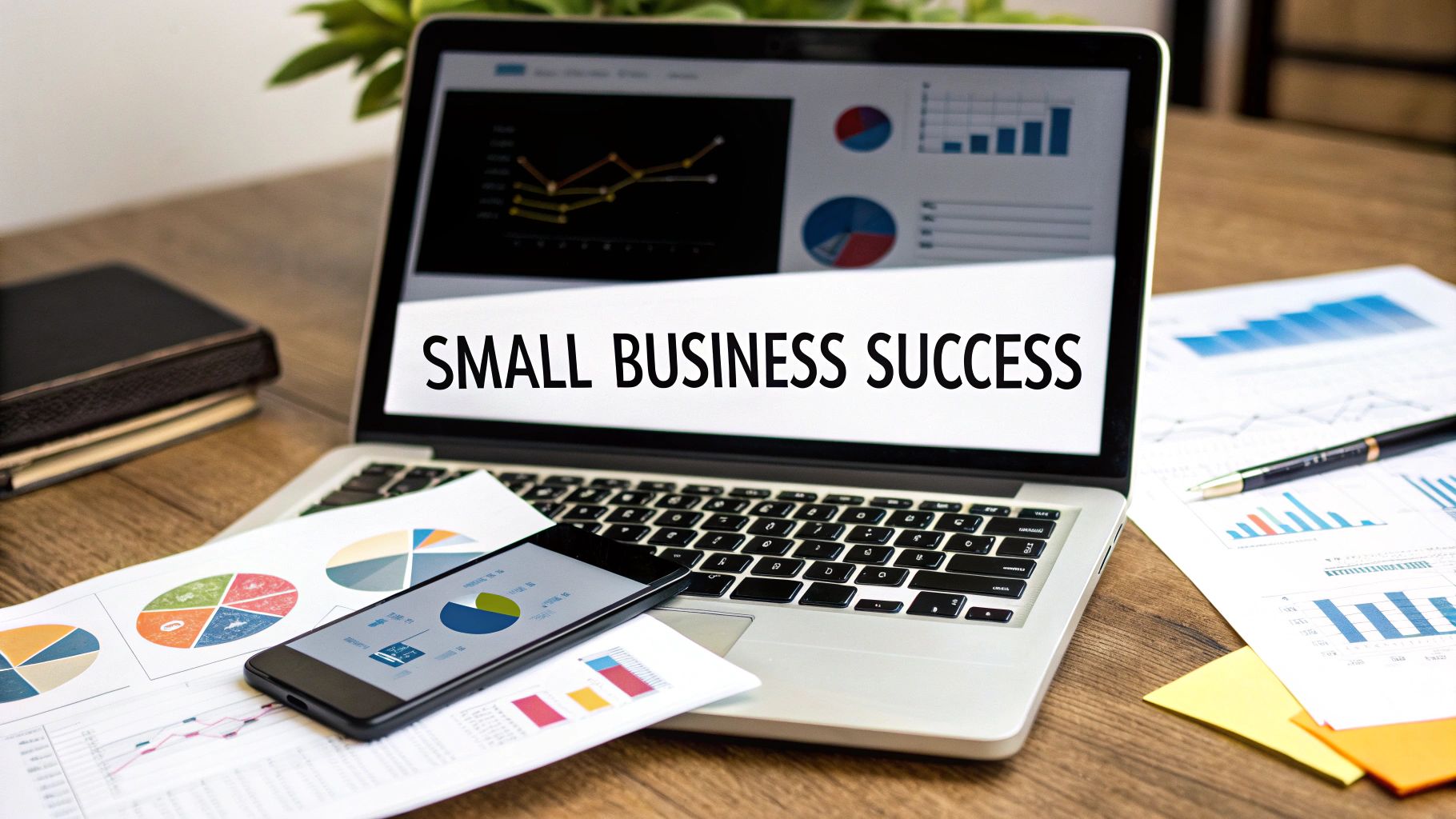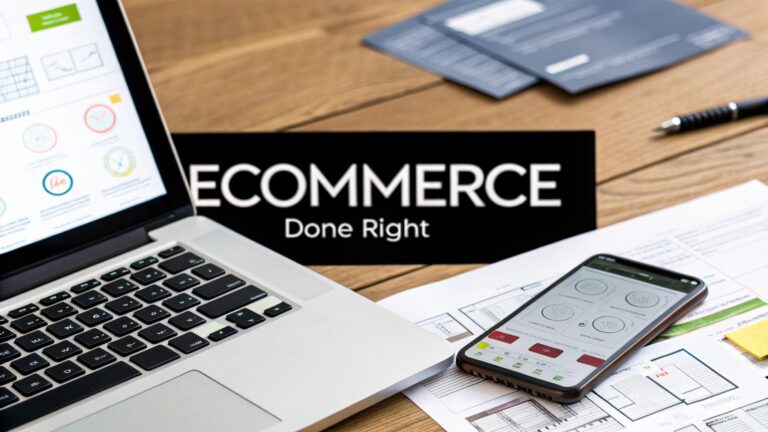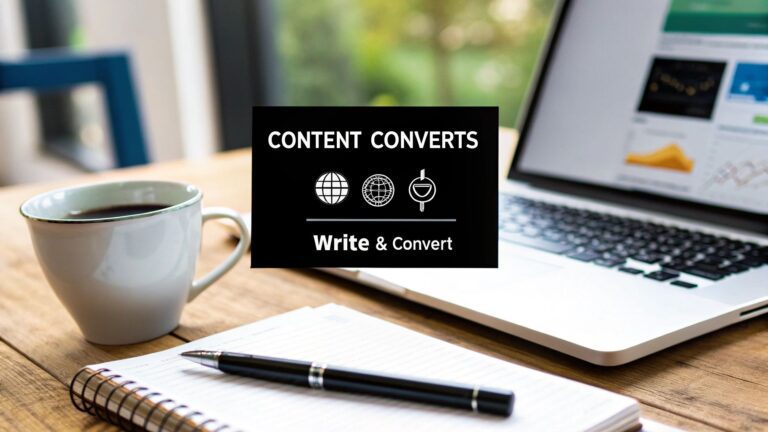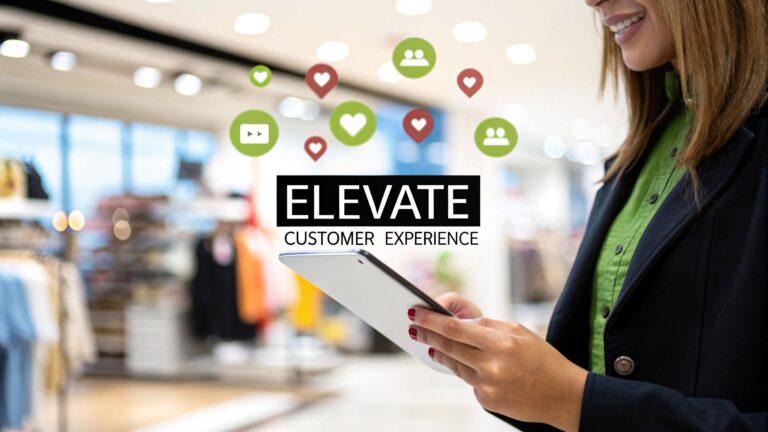Forget the old-school approach of spending a fortune on wide-reaching traditional adverts. For a small business, digital marketing is all about making smart, targeted connections. It’s the great equaliser, letting you talk directly to your ideal customers and measure precisely what’s working and what isn’t. Think of it as the engine for genuine, sustainable business growth.
Why Digital Marketing Is Your Business Growth Engine
Let’s cut through the jargon for a moment. Traditional marketing often feels like shouting into the wind. You take out a newspaper advert or a radio spot and just hope the right person happens to see or hear it. It’s like casting a huge, expensive net into the ocean—you might catch something good, but you’ll also snag a lot you don't want, and the cost adds up fast.
Digital marketing is the complete opposite. It’s like being handed a high-tech fishing rod with a sonar that pings every time your ideal fish swims by. Instead of yelling, you're having a direct conversation with people who are already out there looking for exactly what you sell. That precision is what makes it so incredibly cost-effective.
For any small business serious about expansion, putting effective growth strategies for small business into practice is a must. It's not about trying to outspend the big players; it’s about outsmarting them. You can use focused, measurable campaigns to connect with your local community in Norfolk or attract customers from all over the UK.
Competing on a Level Playing Field
The real power of digital marketing is that it delivers tangible results that directly support your main business goals. This isn't just a theory—it's what UK businesses are actively doing. A recent survey revealed that 54% of businesses said increasing sales revenue was their number one priority. Close behind, 42% were focused on boosting brand awareness and finding new markets. You can see the full breakdown in the UK digital marketing statistics report from LOCALiQ.
This data shows that small businesses are using digital tools for the things that truly matter: growth. You can explore this further in our guide on 5 reasons why digital marketing is important to boost your business.
The fundamental advantage is clear: digital marketing gives you the tools to build relationships, prove your value, and grow your revenue in a way that was once only possible for large corporations.
To really see how these advantages come to life, it helps to break them down. Here’s a quick summary of what digital marketing can do for you.
Core Digital Marketing Benefits for Small Businesses
This table outlines the key benefits digital marketing brings to the table for small businesses like yours.
| Benefit | How It Helps Your Small Business |
|---|---|
| Increased Reach | Connect with customers well beyond your immediate local area, opening up brand new markets. |
| Cost-Effectiveness | Get a much higher return on your investment by targeting specific audiences and often only paying for results. |
| Measurable Results | Track every pound spent. You can see exactly which campaigns are bringing in leads, sales, and engagement. |
| Targeted Advertising | Show your adverts only to people based on their specific interests, online behaviours, and demographics. |
| Builds Relationships | Engage directly with your audience through social media and email, which helps build lasting loyalty and trust. |
Ultimately, each of these benefits works together to create a powerful, cost-effective system for growth.
Building Your Unshakeable Marketing Foundation

Diving headfirst into campaigns without a clear plan is a surefire way to waste your time and money. Before you spend a single pound on an advert, you need to build a solid foundation. This groundwork ensures every marketing action you take is purposeful, measurable, and directly supports your business goals.
Think of it like building a house. You wouldn't dream of putting up walls without a blueprint. In the world of digital marketing for small businesses, your foundation rests on three core pillars: truly understanding your ideal customer, establishing your digital 'home base', and setting clear, actionable goals. Get these right, and everything else falls into place much more easily.
Crafting Your Customer Persona
Let’s be honest, you can't sell effectively if you don't know who you're selling to. This is where a customer persona comes in. It’s a detailed, semi-fictional profile of your ideal customer, going far beyond vague demographics like "women aged 30-50" and creating a living, breathing character.
Give them a name, a job, hobbies, and, most importantly, challenges. What keeps them up at night? What are their aspirations? Where do they scroll for information online?
Imagine a local Norfolk café. They might create a persona called "Chloe, the Remote Worker."
- Role: Freelance graphic designer.
- Pain Points: Struggles to find quiet spots with decent Wi-Fi and good coffee. She often feels a bit isolated working from home.
- Goals: Wants to find a welcoming 'third place' to be productive and feel part of a community.
- Where She Hangs Out: Local Facebook groups, Instagram, and searches Google for "best cafes to work from in Norwich."
All of a sudden, you're not marketing to a faceless crowd anymore. You're creating content and offers specifically for Chloe. That connection makes your messaging far more powerful and relevant.
Your Website Is Your Digital Storefront
Your website is the single most important digital asset you own, period. It's your digital shopfront, open 24/7, making that critical first impression on every potential customer. While social media profiles are fantastic for engagement, they're built on 'rented land' where algorithms and platform rules can change overnight without your consent.
Your website is your property. It’s the central hub where you control the story, capture leads, and guide visitors towards making a purchase. With over half of all web traffic now coming from mobile devices, your site must be mobile-friendly. If visitors have to pinch and zoom just to read your content, they’ll simply leave. A professional, responsive site is non-negotiable, and investing in affordable web design for small business is one of the smartest moves you can make early on.
Setting SMART Goals for Real Results
Finally, you need to know exactly what you're trying to achieve. Vague goals like "get more customers" are impossible to measure and lead to frustration. Instead, you need to set SMART goals.
A SMART goal is Specific, Measurable, Achievable, Relevant, and Time-bound. It turns a fuzzy wish into a concrete action plan, giving your marketing efforts a clear direction and a finish line.
Let's look at the difference between a vague goal and a SMART one:
| Vague Goal | SMART Goal |
|---|---|
| "I want to grow my business online." | "I will generate 20 qualified leads through my website's contact form within the next three months." |
| "I need more social media followers." | "I will increase our Instagram follower count by 15% in the next quarter by posting three times a week and running one targeted ad campaign." |
This approach gives you a clear target. At the end of the period, you can look at the data and know, without a doubt, whether you succeeded. This foundation—built on deep customer understanding, a strong digital home, and clear goals—is what separates hopeful marketing from strategic, results-driven marketing.
Mastering Your Core Digital Marketing Channels
Now that you've got your foundation sorted, it's time to pick your tools. The world of digital marketing for a small business can feel like a bit of a circus, with countless options all vying for your attention. But here's the secret: you don't need to be everywhere at once. The real win is in mastering the channels where your ideal customers already hang out.
Think of each channel as a different way to chat with your audience. Some are brilliant for getting new people interested, while others are perfect for strengthening the relationships you already have. Let's break down the most important ones and turn that overwhelming theory into practical, real-world action.
Demystifying Search Engine Optimisation (SEO)
Search Engine Optimisation, or SEO, might sound complicated, but its job is actually quite simple: make it incredibly easy for search engines like Google to find, understand, and recommend your business. So, when someone in Norfolk types "artisan sourdough bread" into Google, SEO is the magic that helps your bakery pop up at the top of the list.
It’s not about trying to trick the system. It’s about giving Google clear signals that you are a relevant, trustworthy answer to what that person is looking for. These signals include things like the words you use on your website, how quickly your pages load, and whether other reputable sites have linked to yours.
For small businesses, local SEO is an absolute goldmine. This is all about fine-tuning your online presence to pull in customers from your specific town or county. A vital first step is setting up and properly filling out your Google Business Profile. This free tool literally puts you on the map and is often the very first interaction a local customer will have with your brand. To get a head start, you can explore some of the most important local SEO solutions you need to know about to boost your visibility in local searches.
Creating Value with Content Marketing
Content marketing is the art of talking with your customers without always selling to them. Instead of a hard sales pitch, you offer information that's genuinely helpful, interesting, or even entertaining, which addresses their problems and builds a foundation of trust.
It's the difference between a billboard that screams "Buy Our Drills!" and a blog post that teaches someone "How to Hang a Picture Frame Perfectly." The first is an advert; the second is a solution. By providing the solution, you become the go-to expert they trust when it's time to buy that drill.
Your content can come in all sorts of shapes and sizes:
- Blog Posts: Answering common questions your customers have or sharing your expertise.
- How-To Guides: Offering clear, step-by-step instructions related to what you sell.
- Case Studies: Showing off how you've helped another customer get great results.
- Short Videos: Demonstrating a product in action or sharing a quick, useful tip.
The key to making it work is consistency. A simple content calendar—even a basic spreadsheet mapping out one piece of content per week—can keep you on track and ensure you're regularly giving your audience something of value.
Engaging Where Customers Gather on Social Media
Social media isn't about signing up for every platform under the sun. Spreading yourself too thin is a fast track to burnout with very little to show for it. The real goal is to figure out the one or two platforms where your customers actually spend their time and build a real community there.
If you sell beautiful things like handmade jewellery or custom cakes, Instagram and Pinterest are your natural homes. If you’re a B2B consultant offering professional services, LinkedIn is where you need to be. For businesses with a strong local vibe, like a café or a bookshop, Facebook is still a fantastic tool for promoting events and engaging with regulars. To really get the most out of B2B platforms, it's worth checking out the benefits of LinkedIn automation for small businesses to help streamline your outreach.
Remember, your social media plan should be all about interaction, not just broadcasting messages. Ask questions, run polls, and always reply to comments. It’s a two-way conversation that turns casual followers into genuine fans of your business.
Building Direct Relationships with Email Marketing
While social media and SEO are fantastic for helping people discover you, email marketing is your best tool for building direct, lasting relationships. These aren't just random followers; these are people who have actively given you permission to pop into their inbox. They want to hear from you.
This direct line of communication is priceless because you own it. You're not at the mercy of some algorithm change that could suddenly make your posts invisible to your audience. For this reason alone, building your email list should be a top priority for every small business. You can offer a small discount, a free guide, or exclusive tips in exchange for an email address.
Choosing the right mix of channels can feel like a puzzle, but understanding their individual strengths makes it much easier to build a strategy that works for you.
Digital Marketing Channel Comparison for Small Businesses
To help you decide where to focus your energy first, this table breaks down the main channels, giving you a realistic idea of the cost and effort involved.
| Channel | Typical Cost | Time/Effort Required | Best For |
|---|---|---|---|
| SEO | Low to Medium (DIY or agency) | High (Long-term & ongoing) | Building sustainable, long-term traffic and credibility. |
| Content Marketing | Low to Medium (Mainly time) | Medium to High (Consistent creation) | Establishing expertise, building trust, and supporting SEO. |
| Social Media | Low (Organic) to High (Paid) | Medium (Daily engagement) | Building community, brand personality, and direct interaction. |
| Email Marketing | Low (Starts free/cheap) | Low to Medium (Regular campaigns) | Nurturing leads, customer retention, and direct sales. |
| PPC (e.g., Google Ads) | Medium to High (Pay-per-click) | Medium (Campaign management) | Getting immediate traffic and testing offers quickly. |
Ultimately, you don't need to master all of them at once. Start with one or two that feel like the best fit for your business and your customers, and build from there.
This image highlights just how powerful a direct channel like email can be compared to social media for getting your message seen.
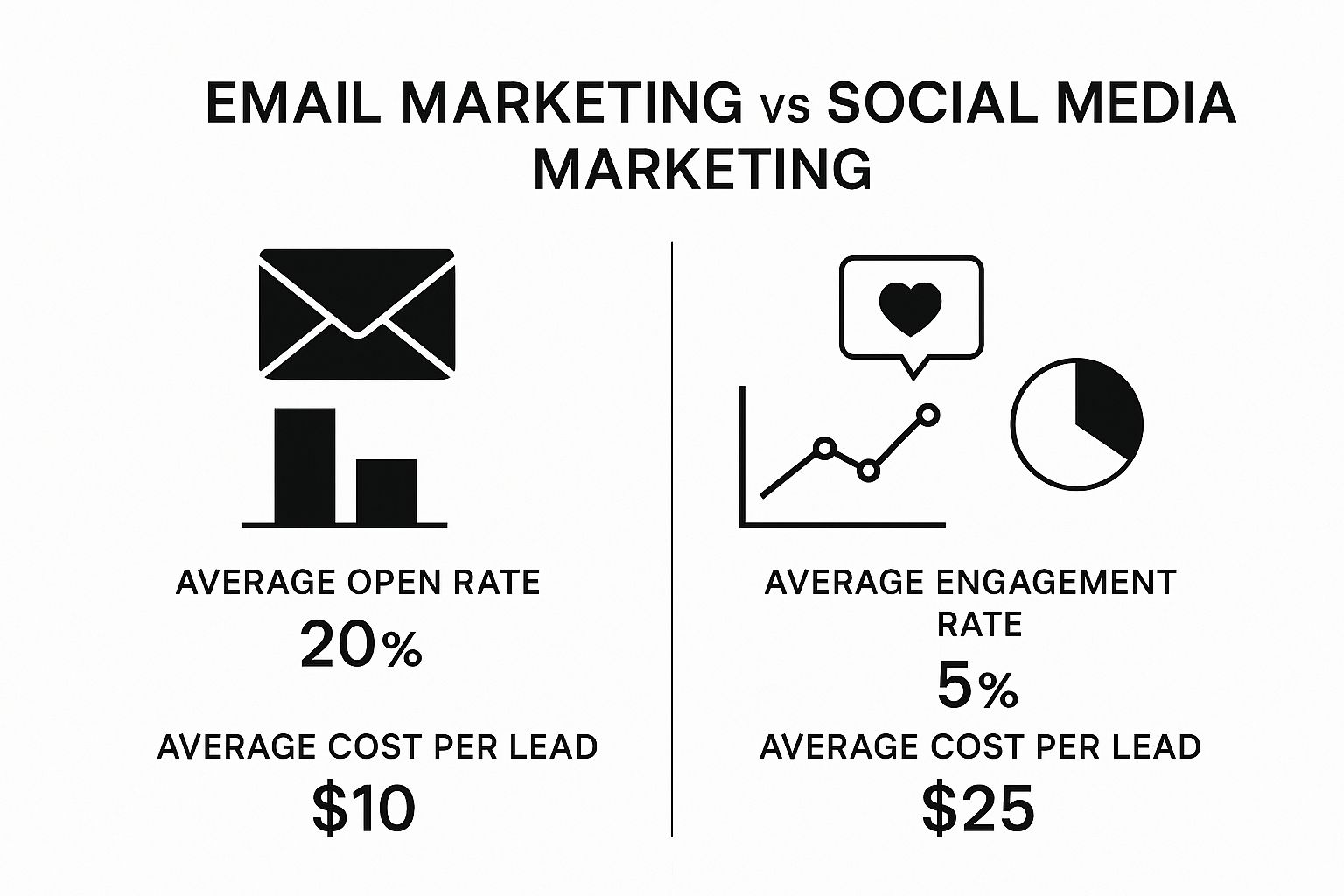
As you can see, email consistently delivers higher engagement and is a more cost-effective way to generate leads. It reinforces why looking after your email list is so crucial. Each channel—SEO, content, social, and email—plays its own part. When you get them working together, they create a powerful system that attracts new customers, keeps them engaged, and turns them into loyal regulars, driving real, sustainable growth for your business.
Putting AI to Work in Your Marketing
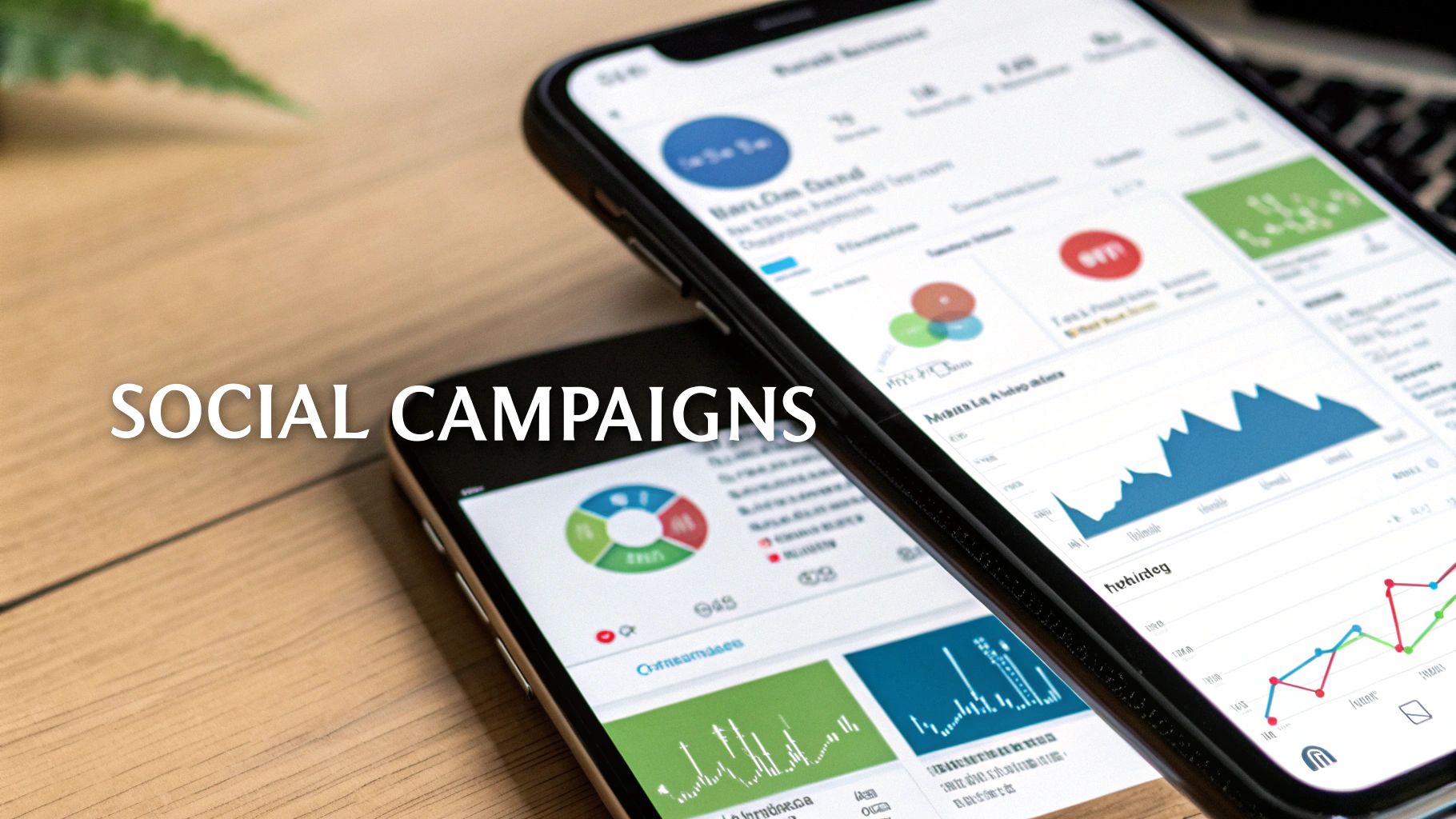
Let's be honest, artificial intelligence (AI) can sound a bit intimidating, something you’d expect to find at a massive tech company. But for small businesses today, AI has become a genuinely practical and affordable tool. Think of it less as a robot and more as a tireless marketing assistant, giving you a real edge without demanding a huge budget.
The biggest win? It takes over the repetitive, time-sapping tasks that can bog any business owner down. This frees you up to focus on the things that actually grow your business—looking after your customers and thinking about the bigger picture.
It’s also brilliant for those moments when you’re stuck for ideas. AI can be a fantastic creative partner, helping you smash through writer's block, simplify your processes, and create polished marketing content much faster than you could alone.
Automating Your Day-to-Day Marketing
Let’s say you run a local café and your Instagram feed is looking a bit neglected. Instead of carving out hours every week to brainstorm, write, and schedule posts, an AI tool could give you a month's worth of post ideas and draft captions in less than an hour.
And it’s not just for social media. The practical uses for a small business are growing all the time.
Here are a few ways you could put it to work right now:
- Generate blog ideas by feeding it the questions your customers are always asking.
- Write the first draft of your website copy, email newsletters, or product descriptions.
- Create unique, eye-catching images for your social media profiles or website banners.
- Analyse customer reviews to quickly pinpoint common praise or problems.
With this kind of help, you can keep your online presence consistent and professional, even when you're stretched thin.
Real-World Examples in Action
To make this feel more real, picture a freelance consultant. They could use an AI-powered chatbot on their website to handle initial enquiries 24/7. The bot can answer common questions, figure out if a lead is a good fit, and even book a discovery call right into their calendar. No more missed opportunities.
Or think about a local plumber. They can use AI to turn the technical jargon on their website into simple, benefit-driven language that homeowners actually understand. That one change can make a huge difference in turning website visitors into paying customers.
The real magic of AI for a small business is how it multiplies your efforts. It handles the groundwork, freeing up your precious time for strategy, building customer relationships, and growing the business.
This isn't just a future trend; UK businesses are already getting on board. A recent survey revealed that around 36% of small business owners planned to use AI for creating marketing content, and nearly 25% were looking to automate parts of their customer service. You can discover more about how UK businesses are applying AI on Statista.
By starting to use these tools, you're not just staying current. You're setting your business up to be more agile and responsive than competitors still stuck doing everything the old-fashioned way. The best approach is to start small with one or two specific tasks—you'll see the benefits almost immediately without feeling overwhelmed.
Creating a Seamless Omnichannel Experience
Have you ever felt like a brand’s marketing was talking past you? You see an advert on one platform, click through to a website that feels completely different, and then get an email that seems to come out of left field. It’s a jarring experience. That kind of disjointed approach creates friction and can make a potential customer lose interest in a heartbeat.
The answer isn't just about using more channels; it's about making them work together to create one unified journey for your customer. This is the whole idea behind omnichannel marketing. It’s about making sure every interaction someone has with your business—whether on social media, your website, or by email—feels like part of a single, intelligent conversation.
Let’s walk through a real-world example. Imagine a customer, we’ll call her Sarah, discovers your local Norfolk gift shop. She sees a sponsored post on Facebook showcasing a new line of handmade pottery. Intrigued, she clicks.
On your website, she doesn't just land on a product page. She finds a blog post telling the story of the local artist who creates the pottery, full of beautiful photos. She has a look around but gets distracted and leaves without buying anything. We’ve all been there. For a small business, this is a make-or-break moment.
From Disjointed to Unified
In a typical, siloed marketing setup, that might be the end of the line. But with an omnichannel approach, the conversation doesn't just stop. The next day, Sarah gets a friendly, automated email. It’s not a generic "you left something in your cart" message. Instead, it mentions her specific interest in the pottery and offers a small 10% discount to nudge her toward completing the purchase.
This feels less like a pushy advert and more like a helpful, personal reminder. The email, the website, and that first Facebook post all feel connected. They’re all part of one smooth experience that understands her journey. This is how you stop just doing marketing and start building a cohesive strategy that creates genuine trust.
Omnichannel isn't just about showing up on multiple channels. It's about orchestrating them so the customer feels understood and valued at every step, making their path to purchase feel natural and effortless.
This connected approach pays dividends, especially when it comes to keeping customers around. In fact, omnichannel marketing has proven incredibly effective for UK businesses. Research shows that companies using omnichannel campaigns see approximately 90% higher customer retention rates compared to those stuck with single-channel methods. You can dig into the full findings on why UK businesses are turning to omnichannel strategies for growth.
Key Elements of an Omnichannel Strategy
So, how do you start building this kind of seamless experience? It boils down to focusing on a few key components that work in harmony:
- A Central Customer Hub: You need a system, even a simple one, to keep track of customer interactions across your different channels. This gives you a single view of each person's journey.
- Consistent Brand Messaging: Make sure your tone of voice, your visual style, and your core messages are the same everywhere. A customer should always know it’s you, no matter where they see you.
- Integrated Technology: Your tools need to talk to each other. For example, by linking your e-commerce store to your email marketing software, you can trigger relevant and timely follow-ups automatically.
By weaving your channels together, you graduate from simply being present online to creating an experience that guides, helps, and ultimately converts customers far more effectively.
Budgeting and Measuring What Truly Matters
Let's talk about money. Marketing costs can feel like a big, scary hurdle for a small business, but it doesn't have to be intimidating. The secret to great digital marketing isn't about having the deepest pockets; it’s about making every single pound work as hard as it possibly can. This all comes down to setting a budget you can live with and, crucially, knowing how to measure what’s actually working.
When you get your budgeting and measurement right, you can move forward with real confidence. You'll know which campaigns are bringing in customers and which are just making noise. This allows you to stop guessing and start making smart, data-backed decisions that genuinely fuel your growth.
Setting a Realistic Digital Marketing Budget
So, how much should you set aside? A good rule of thumb for an established business is to allocate 5-10% of your annual revenue to marketing. If you’re just starting out or pushing for a major growth spurt, you might want to aim a bit higher, perhaps around 10-15%, to give yourself that initial boost.
But remember, these are just guidelines. The most important thing is to start with a number you are genuinely comfortable with. You don’t need a colossal budget to see an impact. You could kick things off by focusing on one or two high-impact, low-cost channels, like local SEO or content marketing, and then build from there as you see results.
The real power comes from what you do next. As you start to see a tangible return on your investment, you can reinvest a slice of that new revenue back into the strategies you've proven are winners.
Moving Beyond Vanity Metrics
One of the most common traps small businesses fall into is chasing vanity metrics. These are the numbers that look fantastic on a report but do absolutely nothing for your bottom line.
Think about things like:
- Page Likes or Follower Counts: Having 10,000 followers is meaningless if not a single one ever buys from you.
- Website Page Views: Heaps of traffic is great, but it’s not much good if visitors arrive and then immediately leave without taking action.
- Impressions: This just tells you how many times your advert was displayed, not whether anyone actually noticed it or cared.
Focusing on vanity metrics is like judging a restaurant's success by how many people walk past the window instead of how many come inside to eat. They don't reflect real business health.
Instead, you need to zero in on the metrics that truly matter—the ones directly tied to your revenue and growth. These are your action metrics:
- Conversion Rate: The percentage of visitors who take a specific, valuable action, like filling out your contact form or making a purchase.
- Cost Per Lead (CPL): How much you're spending, on average, to get one new potential customer through the door.
- Customer Lifetime Value (CLV): The total amount of revenue you can realistically expect from a single customer over their entire relationship with your business.
Tracking these numbers gives you the real story behind your marketing performance.
Using Free Tools to Track Your Success
You don't need to splash out on expensive software to get started. One of the most powerful tools out there is Google Analytics, and it's completely free to use. Getting it set up on your website opens up a window into how people find you and what they do once they're there.
This dashboard gives you a bird's-eye view of your website traffic and user engagement at a glance.
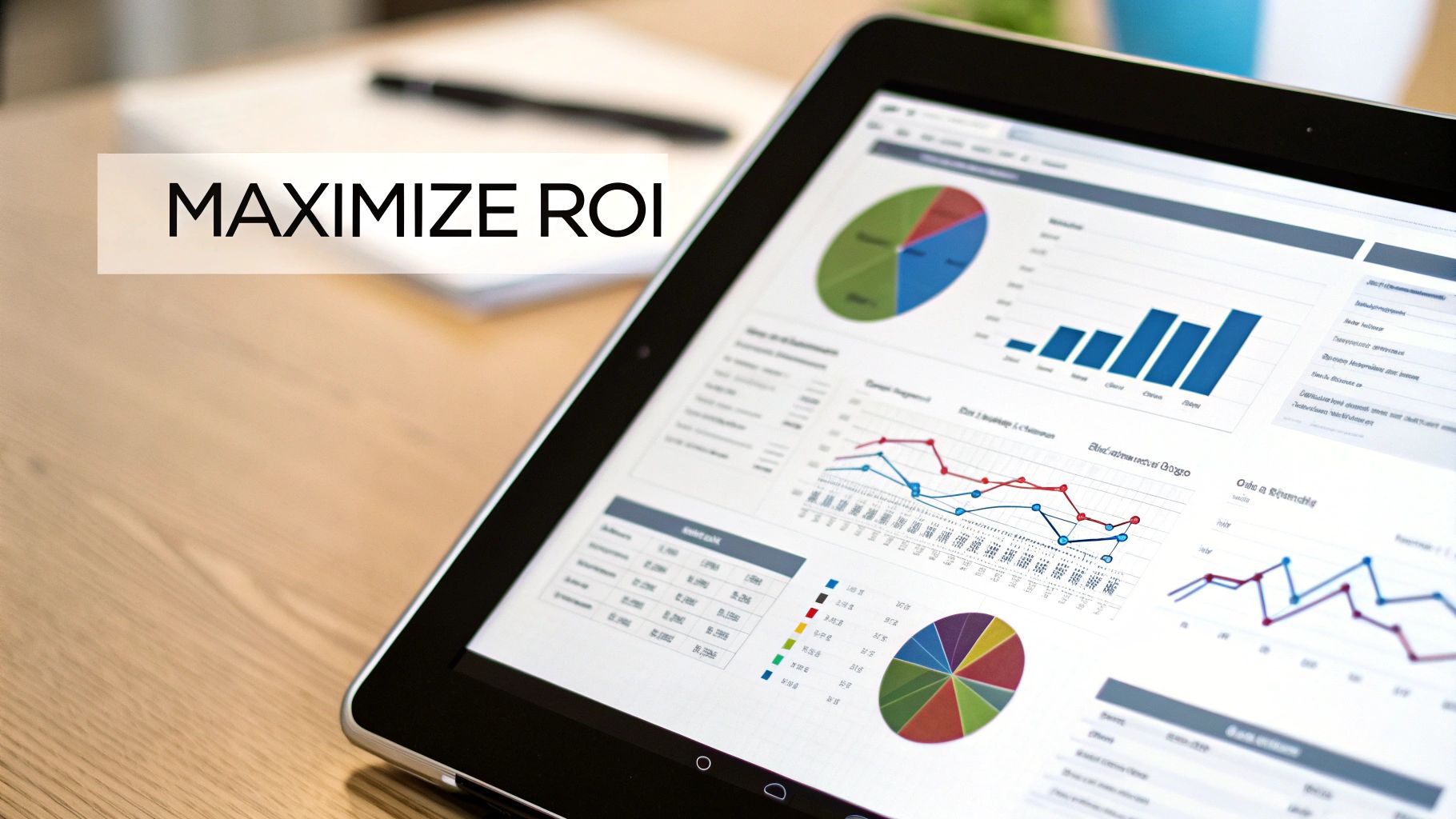
From this single screen, you can learn how many people are visiting your site, where they're coming from (e.g., Google search, social media), and which pages are holding their attention. Think of it as your command centre for understanding performance and making smarter decisions to improve your entire digital marketing strategy.
Got Questions About Digital Marketing? We've Got Answers
Stepping into digital marketing for your small business can feel like learning a new language. It's completely normal to have questions! Let's clear up some of the most common queries I hear from business owners, giving you the practical answers you need to get started and avoid getting stuck.
How Much Should a Small Business Spend on Digital Marketing in the UK?
There's no one-size-fits-all answer here, but a good rule of thumb is to set aside 5-10% of your total revenue for marketing. If you’re a brand-new business trying to make a splash or you're pushing for aggressive growth, you might want to aim a bit higher, perhaps around 10-15%, to build that crucial early momentum.
The most important thing is to start with a budget that feels manageable. Don’t feel pressured to be everywhere at once. It’s far smarter to focus that initial budget on just one or two channels and do them well. As you start to see what’s working, you can reinvest your profits back into the strategies that are actually bringing in customers. That's the beauty of digital marketing—you can start small and scale up as your business and confidence grow.
What Is the Easiest Digital Marketing Channel to Start With?
For most UK small businesses, the friendliest entry points are usually social media marketing and content marketing. The first step is simple: set up a business profile on the social media platform where your customers actually spend their time. Is your audience community-focused? Facebook is probably your best bet. Selling visually appealing products? Instagram is your stage. In the B2B world? LinkedIn is where your conversations should happen.
Once you're set up, focus on creating genuinely helpful content. This doesn't have to be complicated. It could be as simple as a short post explaining what you do, a few photos showing your products in action, or a quick blog article that answers a question you get asked all the time. These channels don't require a huge budget to get going, and they give you a direct line to your community, allowing you to build trust and prove your worth from day one.
Think of social media as your digital shop window and your content as the friendly chat you have with people who wander in. It’s the most straightforward way to build relationships and show people you know your stuff without needing a big upfront investment.
Do I Need a Website if My Business Is on Social Media?
Yes, one hundred percent. Relying solely on social media is like building your business on rented land. The platform owns the property, sets the rules, and can change the algorithm—or even disappear—overnight, taking your audience and hard work with it.
Your website, on the other hand, is your digital real estate. You own it completely. It’s the central hub where all your marketing roads lead. It's where you control the story, guide the customer experience, and ultimately, convert interest into sales. Your website is where you can truly showcase your services, capture email leads, and build long-term SEO value that will benefit you for years to come. Social media is fantastic for grabbing attention, but your website is what turns that attention into a lasting, resilient business.
Ready to build a powerful digital presence that drives real growth? The team at Ibertech Solutions Limited specialises in creating bespoke websites and digital marketing strategies for small businesses across Norfolk and Suffolk. Let's build your success story together. Find out how we can help your business grow.


